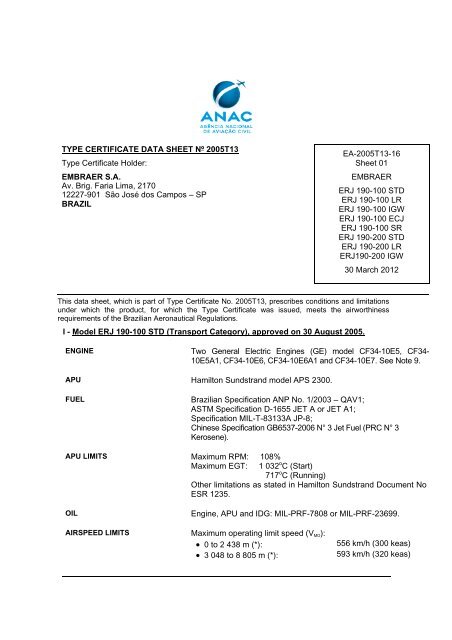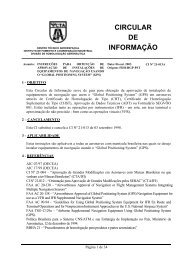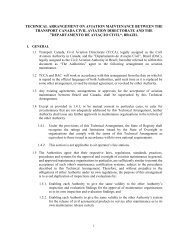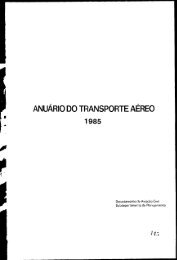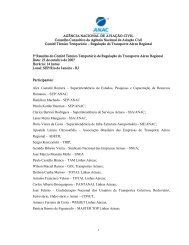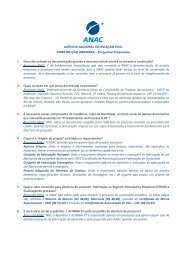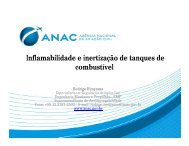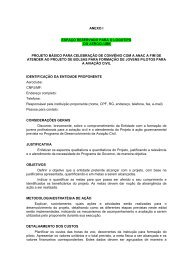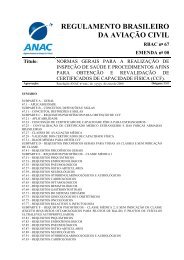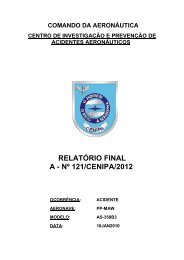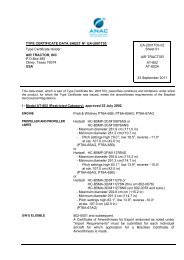You also want an ePaper? Increase the reach of your titles
YUMPU automatically turns print PDFs into web optimized ePapers that Google loves.
TYPE CERTIFICATE DATA SHEET Nº 2005T13<br />
Type Certificate Holder:<br />
EMBRAER S.A.<br />
Av. Brig. Faria Lima, 2170<br />
12227-901 São José dos Campos – SP<br />
BRAZIL<br />
EA-2005T13-16<br />
Sheet 01<br />
EMBRAER<br />
ERJ 190-100 STD<br />
ERJ 190-100 LR<br />
ERJ 190-100 IGW<br />
ERJ 190-100 ECJ<br />
ERJ 190-100 SR<br />
ERJ 190-200 STD<br />
ERJ 190-200 LR<br />
ERJ190-200 IGW<br />
30 March 2012<br />
This data sheet, which is part of Type Certificate No. 2005T13, prescribes conditions and limitations<br />
under which the product, for which the Type Certificate was issued, meets the airworthiness<br />
requirements of the Brazilian Aeronautical Regulations.<br />
I - Model ERJ 190-100 STD (Transport Category), approved on 30 August 2005.<br />
ENGINE Two General Electric Engines (GE) model CF34-10E5, CF34-<br />
10E5A1, CF34-10E6, CF34-10E6A1 and CF34-10E7. See Note 9.<br />
APU Hamilton Sundstrand model APS 2300.<br />
FUEL Brazilian Specification ANP No. 1/2003 – QAV1;<br />
ASTM Specification D-1655 JET A or JET A1;<br />
Specification MIL-T-83133A JP-8;<br />
Chinese Specification GB6537-2006 N° 3 Jet Fuel (PRC N° 3<br />
Kerosene).<br />
APU LIMITS Maximum RPM: 108%<br />
Maximum EGT: 1 032 o C (Start)<br />
717 o C (Running)<br />
Other limitations as stated in Hamilton Sundstrand Document No<br />
ESR 1235.<br />
OIL Engine, APU and IDG: MIL-PRF-7808 or MIL-PRF-23699.<br />
AIRSPEED LIMITS Maximum operating limit speed (V MO):<br />
� 0 to 2 438 m (*): 556 km/h (300 keas)<br />
� 3 048 to 8 805 m (*): 593 km/h (320 keas)
EMBRAER 30 March 2012 EA-2005T13-16 Sheet 2/30<br />
� 8 805 to 12 497 m: 0.82 Mach<br />
(*) Linear variation from 2 438 m to 3 048 m.<br />
Maneuvering speed (V A):<br />
� 0 (*):<br />
� 7 800 m (*):<br />
463 km/h (250 keas)<br />
512 km/h (276 keas)<br />
� 9 962 m (*): 515 km/h (278 keas)<br />
� 9 962 m a 12 497 m: 0.82 Mach<br />
(*) Linear variation between 0, 7 800 m and 9 962 m.<br />
AIRSPEED LIMITS<br />
Maximum flap extended speed (VFE): (Cont.) � Flap Position 1: 426 km/h (230 kcas)<br />
� Flap Position 2: 398 km/h (215 kcas)<br />
� Flap Position 3: 370 km/h (200 kcas)<br />
� Flap Position 4: 333 km/h (180 kcas)<br />
� Flap Position 5: 333 km/h (180 kcas)<br />
� Flap Position Full: 306 km/h (165 kcas)<br />
Maximum landing gear operating speed (VLO): � Retraction:<br />
� Extension:<br />
Maximum landing gear extended<br />
435 km/h (235 keas*)<br />
491 km/h (265 keas*)<br />
* kcas up to 6096 m<br />
speed (VLE): 491 km/h (265 kcas)<br />
Maximum tire ground speed: 362 km/h (225 mph)<br />
C. G. RANGE 47 790 kg 16 117 to 16 953 mm (6% to 28.7% MAC)<br />
(landing gear extended) 47 000 kg 16 117 to 16 964 mm (6% to 29% MAC)<br />
37 000 kg 16 117 to 16 964 mm (6% to 29% MAC)<br />
31 500 kg 16 117 to 16 839 mm (6% to 25.6% MAC)<br />
30 600 kg 16 817 mm (25% MAC)<br />
28 000 kg 16 552 to 16758 mm (17% to 23,4% CMA)<br />
(flight limit extension) 47 790 kg 16 043 to 17 026 mm (4% to 30.7% MAC)<br />
47 000 kg 16 043 to 17 037 mm (4% to 31% MAC)<br />
37 000 kg 16 043 to 17 037 mm (4% to 31% MAC)<br />
31 500 kg 16 043 to 16 912 mm (4% to 27.6% MAC)<br />
28 000 kg 16 448 to 16 831 mm (15% to 25,4% MAC)<br />
Straight-line variation between the points given.<br />
Moment due to landing gear retraction:<br />
� -418 500 kg x mm.<br />
(The aircraft CG is moved forward with the retraction.)<br />
MAXIMUM WEIGHT Ramp: 47 950 kg<br />
Takeoff: 47 790 kg<br />
The area limited by points: 31500kg (6% MAC), 28000kg (17%<br />
MAC), 28000kg (23,4% MAC), 37000kg (29% MAC), 40400kg<br />
(29% MAC), 30100kg (22% MAC), 29500kg (18,4% MAC) is not<br />
allowed for takeoff.
EMBRAER 30 March 2012 EA-2005T13-16 Sheet 3/30<br />
MAXIMUM PASSENGERS 114<br />
Landing: 43 000 kg<br />
Zero Fuel: 40 800 kg<br />
MAXIMUM BAGGAGE Cargo compartment Maximum load (kg)<br />
� Forward: 1 850<br />
� Aft: 1 650<br />
FUEL CAPACITY Maximum usable fuel: 16 152.6 liters (two tanks of 8 076.3 liters<br />
with CG at +16 378 mm).<br />
Unusable fuel: 113.4 liters (56.7 liters at 0.811 kg/liter in each tank).<br />
SERIAL NUMBERS ELIGIBLE 19000002, 19000004, 19000006 and subsequent.<br />
II - Model ERJ 190-100 LR (Transport Category), approved on 30 August 2005.<br />
ENGINE Two General Electric Engines (GE) model CF34-10E5, CF34-<br />
10E5A1, CF34-10E6, CF34-10E6A1 and CF34-10E7.<br />
See Note 9.<br />
APU Hamilton Sundstrand model APS 2300.<br />
FUEL Brazilian Specification ANP No. 1/2003 – QAV1;<br />
ASTM Specification D-1655 JET A or JET A1;<br />
Specification MIL-T-83133A JP-8;<br />
Chinese Specification GB6537-2006 N° 3 Jet Fuel (PRC N° 3<br />
Kerosene).<br />
APU LIMITS Maximum RPM: 108%<br />
Maximum EGT: 1 032 o C (Start)<br />
717 o C (Running)<br />
Other limitations as stated in Hamilton Sundstrand Document No<br />
ESR 1235.<br />
OIL Engine, APU and IDG: MIL-PRF-7808 or MIL-PRF-23699.<br />
AIRSPEED LIMITS Maximum operating limit speed (V MO):<br />
� 0 to 2 438 m (*): 556 km/h (300 keas)<br />
� 3 048 to 8 805 m (*): 593 km/h (320 keas)<br />
� 8 805 to 12 497 m: 0.82 Mach<br />
(*) Linear variation from 2 438 m to 3 048 m.<br />
Maneuvering speed (V A):<br />
� 0 (*):<br />
� 7 800 m (*):<br />
463 km/h (250 keas)<br />
512 km/h (276 keas)<br />
� 9 962 m (*): 515 km/h (278 keas)<br />
� 9 962 m a 12 497 m: 0.82 Mach<br />
(*) Linear variation between 0, 7 800 m and 9 962 m.
EMBRAER 30 March 2012 EA-2005T13-16 Sheet 4/30<br />
Maximum flap extended speed (V FE):<br />
� Flap Position 1: 426 km/h (230 kcas)<br />
� Flap Position 2: 398 km/h (215 kcas)<br />
� Flap Position 3: 370 km/h (200 kcas)<br />
� Flap Position 4: 333 km/h (180 kcas)<br />
� Flap Position 5: 333 km/h (180 kcas)<br />
� Flap Position Full: 306 km/h (165 kcas)<br />
Maximum landing gear operating speed (V LO):<br />
� Retraction<br />
� Extension<br />
435 km/h (235 keas)<br />
491 km/h (265 keas)<br />
* kcas up to 6096 m<br />
Maximum landing gear extended<br />
speed (VLE): 491 km/h (265 kcas)<br />
Maximum tire ground speed: 362 km/h (225 mph)<br />
C. G. RANGE 50 300 kg 16 220 to 16 912 mm (8,8% to 27.6% MAC)<br />
(landing gear extended) 48 090 kg 16 117 to 16 945 mm (6% to 28,5% MAC)<br />
47 000 kg 16 117 to 16 964 mm (6% to 29% MAC)<br />
37 000 kg 16 117 to 16 964 mm (6% to 29% MAC)<br />
31 500 kg 16 117 to 16 839 mm (6% to 25.6% MAC)<br />
30 600 kg 16 817 mm (25% MAC)<br />
28 000 kg 16 552 to 16 758 mm (17% to 23.4% MAC).<br />
(flight limit extension) 50 300 kg 16 146 to 16 986 mm (6,8% to 29.6% MAC)<br />
48 090 kg 16 043 to 17 019 mm (4% to 30,5% MAC)<br />
47 000 kg 16 043 to 17 037 mm (4% to 31% MAC)<br />
37 000 kg 16 043 to 17 037 mm (4% to 31% MAC)<br />
31 500 kg 16 043 to 16 912 mm (4% to 27.6% MAC)<br />
28 000 kg 16 448 to 16831 mm (15% to 25.4% MAC)<br />
Straight-line variation between the points given.<br />
Moment due to landing gear retraction:<br />
� -418 500 kg x mm.<br />
(The aircraft CG is moved forward with the retraction.)<br />
The area limited by points: 31500kg (6% MAC), 28000kg (17%<br />
MAC), 28000kg (23,4% MAC), 37000kg (29% MAC), 40400kg<br />
(29% MAC), 30100kg (22% MAC), 29500kg (18,4% MAC) is not<br />
allowed for takeoff.<br />
MAXIMUM WEIGHT Ramp: 50 460 kg<br />
Takeoff: 50 300 kg<br />
50 000 kg *post mod. BS 190-00-0002<br />
47 790 kg *pós-mod. BS 190-00-0012<br />
Landing: 43 000 kg<br />
Zero Fuel: 40 800 kg<br />
MAXIMUM PASSENGERS 114<br />
MAXIMUM BAGGAGE Cargo compartment Maximum load (kg)
EMBRAER 30 March 2012 EA-2005T13-16 Sheet 5/30<br />
� Forward: 1 850<br />
� Aft: 1 650<br />
FUEL CAPACITY Maximum usable fuel: 16 152.6 liters (two tanks of 8 076.3 liters<br />
with CG at +16 378 mm).<br />
Unusable fuel: 113.4 liters (56.7 liters at 0.811 kg/liter in each<br />
tank)<br />
SERIAL NUMBERS ELIGIBLE 19000002, 19000004, 19000006 and subsequent.<br />
III - Model ERJ 190-100 IGW (Transport Category), approved on 30 August 2005.<br />
ENGINE Two General Electric Engines (GE) model CF34-10E5, CF34-<br />
10E5A1, CF34-10E6, CF34-10E6A1 and CF34-10E7.<br />
See Note 9.<br />
APU Hamilton Sundstrand model APS 2300.<br />
FUEL Brazilian Specification ANP No. 1/2003 – QAV1;<br />
ASTM Specification D-1655 JET A or JET A1;<br />
Specification MIL-T-83133A JP-8;<br />
Chinese Specification GB6537-2006 N° 3 Jet Fuel (PRC N° 3<br />
Kerosene).<br />
APU LIMITS Maximum RPM: 108%<br />
Maximum EGT: 1 032 o C (Start)<br />
717 o C (Running)<br />
Other limitations as stated in Hamilton Sundstrand Document No<br />
ESR 1235.<br />
OIL Engine, APU and IDG: MIL-PRF-7808 or MIL-PRF-23699.<br />
AIRSPEED LIMITS Maximum operating limit speed (V MO):<br />
� 0 to 2 438 m (*): 556 km/h (300 keas)<br />
� 3 048 to 8 805 m (*): 593 km/h (320 keas)<br />
� 8 805 to 12 497 m: 0.82 Mach<br />
(*) Linear variation from 2 438 m to 3 048 m.<br />
Maneuvering speed (V A):<br />
� 0 (*):<br />
� 7 800 m (*):<br />
463 km/h (250 keas)<br />
512 km/h (276 keas)<br />
� 9 962 m (*): 515 km/h (278 keas)<br />
� 9 962 m a 12 497 m: 0.82 Mach<br />
(*) Linear variation between 0, 7 800 m and 9 962 m.<br />
Maximum flap extended speed (V FE):<br />
� Flap Position 1: 426 km/h (230 kcas)<br />
� Flap Position 2: 398 km/h (215 kcas)<br />
� Flap Position 3: 370 km/h (200 kcas)<br />
� Flap Position 4: 333 km/h (180 kcas)
EMBRAER 30 March 2012 EA-2005T13-16 Sheet 6/30<br />
� Flap Position 5: 333 km/h (180 kcas)<br />
� Flap Position Full: 306 km/h (165 kcas)<br />
Maximum landing gear operating speed (V LO):<br />
� Retraction:<br />
� Extension:<br />
Maximum landing gear extended<br />
speed (V LE):<br />
435 km/h (235 keas*)<br />
491 km/h (265 keas*)<br />
* kcas up to 6096 m<br />
491 km/h (265 kcas)<br />
Maximum tire ground speed: 362 km/h (225 mph)<br />
51800 kg 16290 to 16890mm (10.7 % to 27 % MAC)<br />
C. G. RANGE<br />
(landing gear extended) 48 090 kg 16 117 to 16 945 mm (6% to 28.5% MAC)<br />
47 000 kg 16 117 to 16 964 mm (6% to 29% MAC)<br />
37 000 kg 16 117 to 16 964 mm (6% to 29% MAC)<br />
31 500 kg 16 117 to 16 839 mm (6% to 25.6% MAC)<br />
30 600 kg 16 817 mm (25% MAC)<br />
28 000 kg 16 552 to 16 758 mm (17% to 23.4% MAC).<br />
(flight limit extension) 51 800 kg 16 216 to 16 964 mm (8.7% to 29% MAC)<br />
48 090 kg 16 043 to 17 019 mm (4% to 30.5% MAC)<br />
47 000 kg 16 043 to 17 037 mm (4% to 31% MAC)<br />
37 000 kg 16 043 to 17 037 mm (4% to 31% MAC)<br />
31 500 kg 16 043 to 16 912 mm (4% to 27.6% MAC)<br />
28 000 kg 16 448 to 16 831 mm (15% to 25.4% MAC)<br />
Straight-line variation between the points given.<br />
Moment due to landing gear retraction:<br />
� -418 500 kg x mm.<br />
(The aircraft CG is moved forward with the retraction.)<br />
The area limited by points: 31500kg (6% MAC), 28000kg (17% MAC),<br />
28000kg (23,4% MAC), 37000kg (29% MAC), 40400kg (29%<br />
MAC), 30100kg (22% MAC), 29500kg (18,4% MAC) is not allowed<br />
for takeoff.<br />
MAXIMUM WEIGHT Ramp: 51 960 kg (See Note 15)<br />
Takeoff: 51 800 kg (See Note 11)<br />
46 000 kg *pós-mod. BS 190-00-0008<br />
50 000 kg *pós-mod. BS 190-00-0020<br />
MAXIMUM PASSENGERS 114<br />
Landing: 44 000 kg<br />
Zero Fuel: 40 900 kg<br />
MAXIMUM BAGGAGE Cargo compartment Maximum load (kg)<br />
� Forward 1 850<br />
� Aft 1 650
EMBRAER 30 March 2012 EA-2005T13-16 Sheet 7/30<br />
FUEL CAPACITY Maximum usable fuel: 16 152.6 liters (two tanks of 8 076.3 liters<br />
with CG at +16 378 mm).<br />
Unusable fuel: 113.4 liters (56.7 liters at 0.811 kg/liter in each<br />
tank).<br />
SERIAL NUMBERS ELIGIBLE 19000002, 19000004, 19000006 and subsequent.<br />
IV - Model ERJ 190-100 ECJ (Transport Category), approved on 30 October 2007.<br />
ENGINE Two General Electric Engines (GE) model CF34-10E7B or CF34-<br />
10E6. See Note 9.<br />
APU Hamilton Sundstrand model APS 2300.<br />
FUEL Brazilian Specification ANP No. 1/2003 – QAV1;<br />
ASTM Specification D-1655 JET A or JET A1;<br />
Specification MIL-T-83133A JP-8.<br />
Chinese Specification GB6537-2006 N° 3 Jet Fuel (PRC N° 3<br />
Kerosene).<br />
APU LIMITS Maximum RPM: 108%<br />
Maximum EGT: 1 032 o C (Start)<br />
717 o C (Running)<br />
Other limitations as stated in Hamilton Sundstrand Document No<br />
ESR 1235.<br />
OIL Engine, APU and IDG: MIL-PRF-7808 or MIL-PRF-23699.<br />
AIRSPEED LIMITS Maximum operating limit speed (V MO):<br />
� 0 to 2 438 m (*): 556 km/h (300 keas)<br />
� 3 048 to 8 805 m (*): 593 km/h (320 keas)<br />
� 8 805 to 12 497 m: 0.82 Mach<br />
(*) Linear variation from 2 438 m to 3 048 m.<br />
Maneuvering speed (V A):<br />
� 0 to 4 572 m (*): 491 km/h (265 keas)<br />
� 7 800 m (*): 512 km/h (276 keas)<br />
� 9 962 m (*): 515 km/h (278 keas)<br />
� 9 962 m a 12 497 m: 0.82 Mach<br />
(*) Linear variation between 4572 m, 7 800 m and 9 962 m.<br />
Maximum flap extended speed (V FE):<br />
� Flap Position 1: 426 km/h (230 kcas)<br />
� Flap Position 2: 398 km/h (215 kcas)<br />
� Flap Position 3: 370 km/h (200 kcas)<br />
� Flap Position 4: 333 km/h (180 kcas)<br />
� Flap Position 5: 333 km/h (180 kcas)<br />
� Flap Position Full: 306 km/h (165 kcas)
EMBRAER 30 March 2012 EA-2005T13-16 Sheet 8/30<br />
C. G. RANGE<br />
(landing gear extended)<br />
Maximum landing gear operating speed (V LO):<br />
� Retraction:<br />
� Extension:<br />
Maximum landing gear extended<br />
speed (V LE):<br />
435 km/h (235 keas*)<br />
491 km/h (265 keas*)<br />
* kcas up to 6096 m<br />
491 km/h (265 kcas)<br />
Maximum tire ground speed: 362 km/h (225 mph)<br />
54 500 kg 16 415 a 16 849 mm (14,1 % a 25,9 % da CMA)<br />
51 800 kg(*) 16 290 a 16 890 mm (10,7% a 27% da CMA)<br />
48 090 kg 16 117 to 16 945 mm (6% to 28.5% MAC)<br />
47 000 kg 16 117 to 16 964 mm (6% to 29% MAC)<br />
37 000 kg 16 117 to 16 964 mm (6% to 29% MAC)<br />
31 500 kg 16 117 to 16 839 mm (6% to 25.6% MAC)<br />
30 600 kg 16 817 mm (25% MAC)<br />
29 500 kg 16 573 mm (18.4% MAC)<br />
(Values between 29,500 kg and 48,090 are<br />
valid for all ERJ 190-100 ECJ airplanes)<br />
(flight limit extension) 54 500 kg 16 341 to 16 923 mm (12,1 % to 27,9 % MAC)<br />
51 800 kg(*) 16 216 to 16 964 mm (8,7% to 29% MAC)<br />
48 090 kg 16 043 to 17 019 mm (4% to 30.5% MAC)<br />
47 000 kg 16 043 to 17 037 mm (4% to 31% MAC)<br />
37 000 kg 16 043 to 17 037 mm (4% to 31% MAC)<br />
31 500 kg 16 043 to 16 912 mm (4% to 27.6% MAC)<br />
30 600 kg 16 890 mm (27% MAC)<br />
(Values between 30 600 kg and 48 090 kg are<br />
valid for all ERJ 190-100 ECJ airplanes)<br />
Straight-line variation between the points given.<br />
Moment due to landing gear retraction:<br />
� 414 100 kg x mm.<br />
� 418 500 kg x mm. (*)<br />
(The aircraft CG is moved forward with the retraction.)<br />
The area limited by the points: 30 100 kg (22% MAC), 30 600 kg<br />
(25% MAC), 37 000 kg (29% MAC) and 40 400 kg (29% MAC) is<br />
not allowed for takeoff.<br />
MAXIMUM WEIGHT Ramp: 54 700 kg 51 960 kg (*)<br />
Takeoff: 54 500 kg 51 800 kg (*)<br />
Landing: 45 800 kg 44 000 kg (*)<br />
Zero Fuel: 36 500 kg 40 900 kg (*)<br />
35 250 kg * pos-mod SB LIN190-00-<br />
0007-00<br />
MAXIMUM PASSENGERS 19 (limited by RBHA/14 CFR Part 25.807(g))<br />
See note 4.
EMBRAER 30 March 2012 EA-2005T13-16 Sheet 9/30<br />
MAXIMUM BAGGAGE Cargo compartment Maximum load (kg)<br />
� Forward 320<br />
� Aft 1040<br />
FUEL CAPACITY Maximum usable fuel: 27 232.0 liters (16 155 liters in wing tanks<br />
and 11077.0 liters in auxiliary fuel tanks).<br />
Maximum usable fuel: 16 152,6 liters( two tanks of 8 076.3 liters<br />
in wing tanks with CG at +16 378 mm)(*)<br />
Unusable fuel: 165.2 liters (72.1 liters at 0.803 kg/liter in each<br />
wing tank and 21 liters in auxiliary tanks).<br />
Unusable fuel: 113.4 liters (56.7 liters at 0.811 kg/liter in each<br />
wing tank)(*).<br />
SERIAL NUMBERS ELIGIBLE 19000109 and subsequent.<br />
(*) Data applicable only to airplanes S/N 19000109 to 19000225<br />
without SB190LIN-28-0011 incorporated.<br />
V - Model ERJ 190-100 SR (Transport Category), approved on 21 January 2010.<br />
ENGINE Two General Electric Engines (GE) model CF34-10E5A1 and CF34-<br />
10E7. See Note 9.<br />
APU Hamilton Sundstrand model APS 2300.<br />
FUEL Brazilian Specification ANP No. 1/2003 – QAV1;<br />
ASTM Specification D-1655 JET A or JET A1;<br />
Specification MIL-T-83133A JP-8;<br />
Chinese Specification GB6537-2006 N° 3 Jet Fuel (PRC N° 3<br />
Kerosene).<br />
APU LIMITS Maximum RPM: 108%<br />
Maximum EGT: 1 032 o C (Start)<br />
717 o C (Running)<br />
Other limitations as stated in Hamilton Sundstrand Document No<br />
ESR 1235.<br />
OIL Engine, APU and IDG: MIL-PRF-7808 or MIL-PRF-23699.<br />
AIRSPEED LIMITS Maximum operating limit speed (V MO):<br />
� 0 to 2 438 m (*): 556 km/h (300 keas)<br />
� 3 048 to 8 805 m (*): 593 km/h (320 keas)<br />
� 8 805 to 12 497 m: 0.82 Mach<br />
(*) Linear variation from 2 438 m to 3 048 m.<br />
Maneuvering speed (VA): � 0 (*):<br />
� 7 800 m (*):<br />
463 km/h (250 keas)<br />
512 km/h (276 keas)<br />
� 9 962 m (*): 515 km/h (278 keas)
EMBRAER 30 March 2012 EA-2005T13-16 Sheet 10/30<br />
� 9 962 m a 12 497 m: 0.82 Mach<br />
(*) Linear variation between 0, 7 800 m and 9 962 m.<br />
Maximum flap extended speed (VFE): � Flap Position 1: 426 km/h (230 kcas)<br />
� Flap Position 2: 398 km/h (215 kcas)<br />
� Flap Position 3: 370 km/h (200 kcas)<br />
� Flap Position 4: 333 km/h (180 kcas)<br />
� Flap Position 5: 333 km/h (180 kcas)<br />
� Flap Position Full: 306 km/h (165 kcas)<br />
Maximum landing gear operating speed (VLO): � Retraction:<br />
� Extension:<br />
435 km/h (235 keas*)<br />
491 km/h (265 keas*)<br />
* kcas up to 6096 m<br />
Maximum landing gear extended<br />
speed (VLE): 491 km/h (265 kcas)<br />
Maximum tire ground speed: 362 km/h (225 mph)<br />
C. G. RANGE 45 990 kg 16 117 to 16 964 mm (6% to 29% MAC)<br />
(landing gear extended) 37 000 kg 16 117 to 16 964 mm (6% to 29% MAC)<br />
31 500 kg 16 117 to 16 839 mm (6% to 25.6% MAC)<br />
30 600 kg 16 817 mm (25% MAC)<br />
28 000 kg 16 552 to 16758 mm (17% to 23.4% MAC)<br />
(flight limit extension) 45 990 kg 16 043 to 17 037 mm (4% to 31% MAC)<br />
37 000 kg 16 043 to 17 037 mm (4% to 31% MAC)<br />
31 500 kg 16 043 mm (4% MAC)<br />
28 000 kg 16 448 to 16 831 mm (15% to 25.4% MAC)<br />
Straight-line variation between the points given.<br />
Moment due to landing gear retraction:<br />
� -418 500 kg x mm.<br />
(The aircraft CG is moved forward with the retraction.)<br />
MAXIMUM WEIGHT Ramp: 46 150 kg<br />
Takeoff: 45 990 kg<br />
Landing: 43 000 kg<br />
Zero Fuel: 40 800 kg<br />
MAXIMUM PASSENGERS 98<br />
The area limited by points: 31500kg (6% MAC), 28000kg (17%<br />
MAC), 28000kg (23,4% MAC), 37000kg (29% MAC), 40400kg<br />
(29% MAC), 30100kg (22% MAC), 29500kg (18,4% MAC) is not<br />
allowed for takeoff.<br />
MAXIMUM BAGGAGE Cargo compartment Maximum load (kg)<br />
� Forward: 1 850
EMBRAER 30 March 2012 EA-2005T13-16 Sheet 11/30<br />
� Aft: 1 650<br />
Fuel Capacity Maximum usable fuel: 16 152.6 liters (two tanks of 8 076.3 liters<br />
with CG at +16 378 mm).<br />
Unusable fuel: 113.4 liters (56.7 liters at 0.811 kg/liter in each tank).<br />
SERIAL NUMBERS ELIGIBLE 19000339 and on<br />
DATA PERTINENT TO ALL ERJ 190-100 MODELS<br />
DATUM A perpendicular plane to the fuselage centerline, located at<br />
14 443 mm ahead of the wing stub front spar. This spar is<br />
located 414 mm ahead of the wing jack point.<br />
LEVELING MEANS Plumb line between the points P1 to P2 located inside the<br />
landing gear compartment on the left side, as illustrated below.<br />
MEAN AERODYNAMIC CHORD Length: 3 682 mm.<br />
Leading edge of mean aerodynamic chord: X: 15 896 mm<br />
Y: �5 644 mm<br />
Z: �663 mm<br />
Certification basis RBHA 25 (Airworthiness Requirements - Transport Category<br />
Aircraft), corresponding to 14 CFR Part 25, including<br />
amendments 25-1 through 25-101, plus the following<br />
amendments:<br />
� Amendment 25-102, except paragraph 25.981(c);<br />
� Amendment 25-103, integral;<br />
� Amendment 25-104, integral;<br />
� Amendment 25-105, integral;<br />
� Amendment 25-107, except paragraph 25.735(h);<br />
� Amendment 25-108, integral;<br />
� Amendment 25-109, integral;<br />
� Amendment 25-110, integral;<br />
� Amendment 25-112, integral;<br />
� Amendment 25-113, integral;<br />
� Amendment 25-114, integral;<br />
� Amendment 25-117, integral; and<br />
� Amendment 25-120, integral.<br />
_<br />
Note: ERJ 190-100 auxiliary fuel tanks complies with<br />
amendment 102 paragraph 25.981(c).
EMBRAER 30 March 2012 EA-2005T13-16 Sheet 12/30<br />
CERTIFICATION BASIS<br />
(Cont.)<br />
Special Conditions:<br />
� Engine torque loads for sudden engine stoppage (RBHA<br />
21.16; RBHA/14 CFR Part 25.361) - FCAR HES-01;<br />
� Interaction of systems and structures (RBHA 21.16;<br />
RBHA/14 CFR Part 25.671 and 25.1309) - FCAR HES-06;<br />
� High intensity radiated fields (HIRF) protection (RBHA 21.16,<br />
RBHA/14 CFR Part 25.1309, 25.1333, 25.1431 and<br />
25.1529) - FCAR HSI-01;<br />
� Operation without normal electrical power (RBHA 21.16,<br />
RBHA/14 CFR Part 25.1165(b), 25.1309, 25.1333(b) and<br />
25.1351) - FCAR HSI-02;<br />
� Electronic flight control system: control surface position<br />
awareness (RBHA 21.16, RBHA/14 CFR Part 21.16, 25.143,<br />
25.671 and 25.672) - FCAR HDE-02;<br />
� Performance credit for ATTCS during go-around (RBHA<br />
21.16, RBHA 25.117, 25.119(a), 25.121(d), 25.904, 25.1309<br />
and Appendix I) - FCAR HDE-17;<br />
� “Steep Approach Mode Functionality (SAM)” (RBHA/14 CFR<br />
Part 21.26, 25.125, 25.143(g) & 25.143(b)) - FCAR HDE-27;<br />
and<br />
� “Seats with Non-Traditional, Large, and Non-Metallic Panels”<br />
(RBHA/14 CFR Part 25.853) – FCAR HES-44.<br />
DATA PERTINENT TO ERJ 190-100 ECJ:<br />
“Interaction of systems and structures” (RBHA 21.16; RBHA/14<br />
CFR Part 25.671 & 25.1309) - FCAR ES-06.<br />
Equivalent Levels of Safety Findings:<br />
� Checked maneuver loads (RBHA 21.21(b)(1); RBHA/14 CFR<br />
Part 25.331(c)(2)) - FCAR HES-13;<br />
� Fuel tank crashworthiness (RBHA 21.21(b)(1); RBHA/14<br />
CFR Part 25.721 and 25.963(d)) - FCAR HES-19;<br />
� Minor crash criteria (RBHA 21.21(b)(1); RBHA/14 CFR Part<br />
25.721 and 25.963(d)) - FCAR HES-20;<br />
� Emergency exit locator signs (RBHA 21.21(b)(1); RBHA/14<br />
CFR Part 25.811(d)(3)) - FCAR HES-36.<br />
� Equipment, systems and installations (RBHA 21.21(b)(1);<br />
RBHA/14 CFR Part 25.1309) - FCAR HSI-15;<br />
� Equivalent level of safety finding for position lights (RBHA<br />
21.21(b)(1); RBHA/14 CFR Part 25.1389(b), 25.1391,<br />
25.1393 & 25.1395) - FCAR HSI-27;<br />
� Cabin ventilation – humidity requirement (RBHA 21.21(b)(1),<br />
RBHA/14 CFR Part 25.831(g)) - FCAR HSI-38;<br />
� Performance credit for use of automatic power reserve (APR)<br />
during reduced thrust takeoffs (RBHA 21.21(b)(1); RBHA/14<br />
CFR Part 25.904, 25.149 and Appendix I) - FCAR HDE-16;<br />
� Flight critical thrust reverser (RBHA 21.21(b)(1); RBHA/14 CFR<br />
Part 25.933(a)(1)(ii) & 25.1309(b)(1) - FCAR HPR-06;<br />
� Digital only display of turbine engine high/intermediate pressure<br />
rotor speed (N2) (RBHA 21.21(b)(1); RBHA/14 CFR Part 25.901,<br />
25.1305, 25.1309, 25.1321 and 25.1549) - FCAR HPR-14;<br />
� Adoption of APU harmonized requirements (RBHA<br />
21.21(b)(1); RBHA/14 CFR Part 25 Subparts E, F and G) -<br />
FCAR HPR-17; and
EMBRAER 30 March 2012 EA-2005T13-16 Sheet 13/30<br />
� Lack of on/off switch for ATTCS system (RBHA 21.21(b)(1);<br />
RBHA/14 CFR Part 25.117, 25.119(a), 25.121(d), 25.904,<br />
25.1301, 25.1309, Appendix I) - FCAR HPR-23.
EMBRAER 30 March 2012 EA-2005T13-16 Sheet 14/30<br />
CERTIFICATION BASIS<br />
(Cont.)<br />
DATA PERTINENT TO ERJ 190-100 ECJ:<br />
� “Emergency Exit Locator Sign near Type III Door” (RBHA<br />
21.21(b)(1); RBHA/14 CFR Part 25.811(d)(1)) – FCAR EI-01.<br />
� “Emergency Exit Locator Sign near Type I Door” (RBHA<br />
21.21(b)(1); RBHA/14 CFR Part 25.811(d)(3)) – FCAR EI-02.<br />
� “Emergency Exit Sign Dimensions” (RBHA 21.21(b)(1);<br />
RBHA/14 CFR Part 25.812(b)(1) – FCAR EI-03.<br />
� “In-flight Accessible Class C Baggage Compartment” (RBHA<br />
21.21(b)(1); RBHA/14 CFR Part 25.857(c)) – FCAR EI-04.<br />
Exemptions:<br />
� Uncontained engine rotor burst hitting pressurized cabin<br />
[RBHA/14 CFR Part 25.841(a)(2)(i) and (ii)] - Granted<br />
through Ordinance DAC (ANAC) No. 595/DGAC, dated 28<br />
June 2005; and<br />
� Uncontrollable high engine thrust [RBHA/14 CFR Part<br />
25.901(c)] - Granted through Ordinance DAC (ANAC) No.<br />
548/DGAC, dated 16 June 2005.<br />
DATA PERTINENT TO ERJ 190-100 ECJ:<br />
� “Passenger Cabin Interior Doors” [RBHA 11.25(b)(5);<br />
RBHA/14 CFR Part 25.813(e)] – EI-05, Granted through<br />
Ordinance DAC (ANAC) No. 299/ANAC dated 18 August<br />
2008;<br />
� “Firm Handhold” [RBHA 21.21(b)(1); RBHA/14 CFR Part<br />
25.785(j)] – EI-06, Granted through Ordinance DAC (ANAC)<br />
No. 298/ANAC dated 18 August 2008;<br />
� “Dynamic Test Requirements for Side-Facing Divans (Sofas)<br />
/ General Occupant Protection for Occupants of Multiple<br />
Place Side-facing Seats (Divans) Installation” [RBHA<br />
11.25(b)(5); 25.562, 25.785] – EI-07, Granted through<br />
Ordinance DAC (ANAC) No. 300/ANAC dated 18 August<br />
2008.<br />
Noise Standards:<br />
� RBHA 36 (Noise Standard - Type Certification), corresponding<br />
to ICAO Annex 16, Volume I Chapter 3 (third edition), and<br />
including all amendments effective on the date the ERJ-190<br />
certification by the ANAC.<br />
Fuel venting and exhaust emission requirements:<br />
� RBHA 34 (Fuel Venting and Exhaust Emission Requirements<br />
for Turbine Engine Powered Airplanes - Type Certification),<br />
corresponding to the 14 CFR Part 34 and including the<br />
amendment effective on the date the ERJ-190 certification by<br />
the ANAC.<br />
Optional design requirements complied with:<br />
� RBHA/14 CFR Part 25.801 – Ditching;
EMBRAER 30 March 2012 EA-2005T13-16 Sheet 15/30<br />
CERTIFICATION BASIS<br />
(Cont.)<br />
� RBHA/14 CFR Part 25.1403 – Wing icing detection lights;<br />
� RBHA/14 CFR Part 25.1411 and 25.1415 – Safety<br />
equipment required for ditching certification;<br />
� RBHA/14 CFR Part 25.1419 – Ice protection; and<br />
� RBHA/14 CFR Part 25.1421 – Megaphones.<br />
Application date for type certification:<br />
� ERJ 190-100 STD: 30 May 2001;<br />
� ERJ 190-100 LR: 30 May 2001;<br />
� ERJ 190-100 IGW: 30 May 2001; and<br />
� ERJ 190-100 ECJ: 16 November 2006.<br />
PRODUCTION BASIS Production approved under CHE E-7203-01, dated 11 Dec. 2008.<br />
Required Equipment The basic required equipment as prescribed in the applicable<br />
airworthiness regulations (see certification basis) must be<br />
installed in the airplane. The approved equipment is listed in the<br />
Embraer Technical Report 190-100TDSD.<br />
The ANAC approved airplane flight manual P/N AFM-1868 must<br />
be on board.<br />
VI - Model ERJ 190-200 STD (Transport Category), approved on 30 June 2006.<br />
ENGINE Two General Electric Engines (GE) model CF34-10E5, CF34-<br />
10E5A1, CF34-10E6, CF34-10E6A1 and CF34-10E7.<br />
See Note 9.<br />
APU Hamilton Sundstrand model APS 2300.<br />
FUEL Brazilian Specification ANP No. 1/2003 – QAV1;<br />
ASTM Specification D-1655 JET A or JET A1;<br />
Specification MIL-T-83133A JP-8;<br />
Chinese Specification GB6537-2006 N° 3 Jet Fuel (PRC N° 3<br />
Kerosene).<br />
APU LIMITS Maximum RPM: 108%<br />
Maximum EGT: 1 032 o C (Start)<br />
717 o C (Running)<br />
Other limitations as stated in Hamilton Sundstrand Document No<br />
ESR 1235.<br />
OIL Engine, APU and IDG: MIL-PRF-7808 or MIL-PRF-23699.<br />
AIRSPEED LIMITS Maximum operating limit speed (V MO):<br />
� 0 to 2 438 m (*): 556 km/h (300 keas)<br />
� 3 048 to 8 805 m (*): 593 km/h (320 kcas)<br />
� 8 805 to 12 497 m: 0.82 Mach<br />
(*) Linear variation from 2 438 m to 3 048 m.
EMBRAER 30 March 2012 EA-2005T13-16 Sheet 16/30<br />
Maneuvering speed (V A):<br />
� 0 (*):<br />
� 7 800 m (*):<br />
469 km/h (253 keas)<br />
515 km/h (278 keas)<br />
� 9 920 m (*): 517 km/h (279 keas)<br />
� 9 920 m a 12 497 m: 0.82 Mach<br />
(*) Linear variation between 0, 7 800 m and 9 920 m.<br />
AIRSPEED LIMITS Maximum flap extended speed (VFE): (Cont.) � Flap Position 1: 426 km/h (230 kcas)<br />
� Flap Position 2: 398 km/h (215 kcas)<br />
� Flap Position 3: 370 km/h (200 kcas)<br />
� Flap Position 4: 333 km/h (180 kcas)<br />
� Flap Position 5: 333 km/h (180 kcas)<br />
� Flap Position Full: 306 km/h (165 kcas)<br />
Maximum landing gear operating speed (VLO): � Retraction:<br />
� Extension:<br />
463 km/h (250 keas*)<br />
491 km/h (265 keas*)<br />
* kcas up to 6096 m<br />
Maximum landing gear extended<br />
speed (VLE): 491 km/h (265 kcas)<br />
Maximum tire ground speed: 362 km/h (225 mph)<br />
CG RANGE 48 790 kg 16 966 to 17 849 mm (7% to 31% MAC)<br />
(landing gear extended) 38 000 kg 16 966 to 17 849 mm (7% to 31% MAC)<br />
31 800 kg 16 966 to 17 724 mm (7% to 27.6% MAC)<br />
30 600 kg 17 702 mm (27% MAC)<br />
29 500 kg 17 285 mm (18.4% MAC)<br />
(flight limit extension) 48 790 kg 16 892 to 17 905 mm (5% to 32.5% MAC)<br />
38 000 kg 16 892 to 17 905 mm (5% to 32.5% MAC)<br />
31 800 kg 16 892 to 17 776 mm (5% to 29% MAC)<br />
30 600 kg 17 757 mm (28,5% MAC)<br />
48 790 kg 16 966 to 17 849 mm (7 to 31% MAC)<br />
38 000 kg 16 966 to 17 849 mm (7 to 31% MAC)<br />
CG RANGE (Cont.) Straight-line variation between the points given.<br />
Moment due to landing gear retraction:<br />
� -418 500 kg x mm.<br />
(The aircraft CG is moved forward with the retraction.)<br />
� The area limited by the points: 30 100 kg (22% MAC), 30 600<br />
kg (27% MAC), 38 000 kg (31% MAC) and 43 400 kg (31%<br />
MAC) is not allowed for takeoff.<br />
MAXIMUM WEIGHT Ramp: 48 950 kg<br />
Takeoff: 48 790 kg<br />
Landing: 45 000 kg<br />
Zero Fuel: 42 500 kg
EMBRAER 30 March 2012 EA-2005T13-16 Sheet 17/30<br />
MAXIMUM PASSENGERS 124<br />
MAXIMUM BAGGAGE Cargo Compartment: Maximum Load (kg):<br />
� Forward 1 900<br />
� Aft 1 800<br />
Fuel Capacity Maximum usable fuel: 16 152.6 liters (two tanks of 8 076.3 liters<br />
with CG at +17 191 mm).<br />
Unusable fuel: 113.4 liters (56.7 liters at 0.811 kg/liter in each<br />
tank).<br />
SERIAL NUMBERS ELIGIBLE 19000005, 19000029 and subsequent.<br />
VII - Model ERJ 190-200 LR (Transport Category), approved on 30 June 2006.<br />
ENGINE Two General Electric Engines (GE) model CF34-10E5, CF34-<br />
10E5A1, CF34-10E6, CF34-10E6A1 and CF34-10E7.<br />
See Note 8.<br />
APU Hamilton Sundstrand model APS 2300.<br />
FUEL Brazilian Specification ANP No. 1/2003 – QAV1;<br />
ASTM Specification D-1655 JET A or JET A1;<br />
Specification MIL-T-83133A JP-8;<br />
Chinese Specification GB6537-2006 N° 3 Jet Fuel (PRC N° 3<br />
Kerosene).<br />
APU LIMITS Maximum RPM: 108%<br />
Maximum EGT: 1 032 o C (Start)<br />
717 o C (Running)<br />
Other limitations as stated in Hamilton Sundstrand Document No<br />
ESR 1235.<br />
OIL Engine, APU and IDG: MIL-PRF-7808 or MIL-PRF-23699.<br />
AIRSPEED LIMITS Maximum operating limit speed (V MO):<br />
� 0 to 2 438 m (*): 556 km/h (300 keas)<br />
� 3 048 to 8 805 m (*): 593 km/h (320 kcas)<br />
� 8 805 to 12 497 m: 0.82 Mach<br />
(*) Linear variation from 2 438 m to 3 048 m.<br />
Maneuvering speed (V A):<br />
� 0 (*):<br />
� 7 800 m (*):<br />
469 km/h (253 keas)<br />
515 km/h (278 keas)<br />
� 9 920 m (*): 517 km/h (279 keas)<br />
� 9 920 m to 12 497 m: 0.82 Mach<br />
(*) Linear variation between 0, 7 800 m and 9 962 m.<br />
Maximum flap extended speed (V FE):
EMBRAER 30 March 2012 EA-2005T13-16 Sheet 18/30<br />
� Flap Position 1: 426 km/h (230 kcas)<br />
� Flap Position 2: 398 km/h (215 kcas)<br />
� Flap Position 3: 370 km/h (200 kcas)<br />
� Flap Position 4: 333 km/h (180 kcas)<br />
� Flap Position 5: 333 km/h (180 kcas)<br />
� Flap Position Full: 306 km/h (165 kcas)<br />
Maximum landing gear operating speed (VLO): � Retraction:<br />
� Extension:<br />
463 km/h (235 keas*)<br />
491 km/h (265 keas*)<br />
* kcas up to 6096 m<br />
Maximum landing gear extended<br />
speed (VLE): 491 km/h (265 kcas)<br />
Maximum tire ground speed: 362 km/h (225 mph)<br />
CG RANGE 50 790 kg 17 058 to 17 849 mm (9.5 to 31% MAC)<br />
(landing gear extended) 48 790 kg 16 966 to 17 849 mm (7% to 31% MAC)<br />
38 000 kg 16 966 to 17 849 mm (7% to 31% MAC)<br />
31 800 kg 16 966 to 17 724 mm (7% to 27.6% MAC)<br />
30 600 kg 17 702 mm (27% MAC)<br />
29 500 kg 17 385 mm (18.4% MAC)<br />
(flight limit extension) 50 790 kg 16 966 to 17 849 mm (7,5 to 31% MAC)<br />
48 790 kg 16 892 to 17 905 mm (5% to 32.5% MAC)<br />
38 000 kg 16 892 to 17 905 mm (5% to 32.5% MAC)<br />
31 800 kg 16 892 to 17 776 mm (5% to 29% MAC)<br />
30 600 kg 17 757 mm (28,5% MAC)<br />
MAXIMUM WEIGHT Ramp: 50 590 kg<br />
Takeoff: 50 790 kg<br />
Landing: 45 000 kg<br />
Zero Fuel: 42 500 kg<br />
MAXIMUM PASSENGERS 124<br />
Straight-line variation between the points given.<br />
Moment due to landing gear retraction:<br />
� -418 500 kg x mm.<br />
(The aircraft CG is moved forward with the retraction.)<br />
� The area limited by the points: 30 100 kg (22% MAC), 30 600<br />
kg (27% MAC), 38 000 kg (31% MAC) and 43 400 kg (31%<br />
MAC) is not allowed for takeoff.<br />
MAXIMUM BAGGAGE Cargo Compartment: Maximum Load (kg):<br />
� Forward 1 900<br />
� Aft 1 800
EMBRAER 30 March 2012 EA-2005T13-16 Sheet 19/30<br />
Fuel Capacity Maximum usable fuel: 16 152.6 liters (two tanks of 8 076.3 liters<br />
with CG at +17 191 mm).<br />
Unusable fuel: 113.4 liters (56.7 liters at 0.811 kg/liter in each<br />
tank).<br />
SERIAL NUMBERS ELIGIBLE 19000005, 19000029 and subsequent.<br />
VIII - Model ERJ 190-200 IGW (Transport Category), approved on 30 June 2006.<br />
ENGINE Two General Electric Engines (GE) model CF34-10E5, CF34-<br />
10E5A1, CF34-10E6, CF34-10E6A1 and CF34-10E7.<br />
See Note 8.<br />
APU Hamilton Sundstrand model APS 2300.<br />
FUEL Brazilian Specification ANP No. 1/2003 – QAV1;<br />
ASTM Specification D-1655 JET A or JET A1;<br />
Specification MIL-T-83133A JP-8;<br />
Chinese Specification GB6537-2006 N° 3 Jet Fuel (PRC N° 3<br />
Kerosene).<br />
APU LIMITS Maximum RPM: 108%<br />
Maximum EGT: 1 032 o C (Start)<br />
717 o C (Running)<br />
Other limitations as stated in Hamilton Sundstrand Document No<br />
ESR 1235.<br />
OIL Engine, APU and IDG: MIL-PRF-7808 or MIL-PRF-23699.<br />
AIRSPEED LIMITS Maximum operating limit speed (V MO):<br />
� 0 to 2 438 m (*): 556 km/h (300 keas)<br />
� 3 048 to 8 805 m (*): 593 km/h (320 kcas)<br />
� 8 805 to 12 497 m: 0.82 Mach<br />
(*) Linear variation from 2 438 m to 3 048 m.<br />
Maneuvering speed (V A):<br />
� 0 (*):<br />
� 7 800 m (*):<br />
469 km/h (253 keas)<br />
515 km/h (278 keas)<br />
� 9 920 m (*): 517 km/h (279 keas)<br />
� 9 920 m to 12 497 m: 0.82 Mach<br />
(*) Linear variation between 0, 7 800 m and 9 962 m.<br />
AIRSPEED LIMITS (Cont.) Maximum flap extended speed (V FE):<br />
� Flap Position 1: 426 km/h (230 kcas)<br />
� Flap Position 2: 398 km/h (215 kcas)<br />
� Flap Position 3: 370 km/h (200 kcas)<br />
� Flap Position 4: 333 km/h (180 kcas)
EMBRAER 30 March 2012 EA-2005T13-16 Sheet 20/30<br />
� Flap Position 5: 333 km/h (180 kcas)<br />
� Flap Position Full: 306 km/h (165 kcas)<br />
Maximum landing gear operating speed (VLO): � Retraction:<br />
� Extension:<br />
463 km/h (235 keas*)<br />
491 km/h (265 keas*)<br />
* kcas up to 6 096 m<br />
Maximum landing gear extended<br />
speed (VLE): 491 km/h (265 kcas)<br />
Maximum tire ground speed: 362 km/h (225 mph)<br />
CG RANGE 52 290 kg 17 124 to 17 849 mm (11.3 to 31% MAC)<br />
(landing gear extended) 48 790 kg 16 966 to 17 849 mm (7% to 31% MAC)<br />
38 000 kg 16 966 to 17 849 mm (7% to 31% MAC)<br />
31 800 kg 16 966 to 17 724 mm (7% to 27.6% MAC)<br />
30 600 kg 17 702 mm (27% MAC)<br />
29 500 kg 17 385 mm (18.4% MAC)<br />
(flight limit extension) 52 290 kg 17 050 to 17 849 mm (7,5 to 31% MAC)<br />
48 790 kg 16 892 to 17 905 mm (5% to 32.5% MAC)<br />
38 000 kg 16 892 to 17 905 mm (5% to 32.5% MAC)<br />
31 800 kg 16 892 to 17 776 mm (5% to 29% MAC)<br />
30 600 kg 17 757 mm (28,5% MAC)<br />
CG RANGE<br />
(Cont.)<br />
MAXIMUM WEIGHT Ramp: 52 450 kg<br />
Takeoff: 52 290 kg<br />
Landing: 45 800 kg<br />
Zero Fuel: 42 600 kg<br />
MAXIMUM PASSENGERS 124<br />
Straight-line variation between the points given.<br />
Moment due to landing gear retraction:<br />
� -418 500 kg x mm.<br />
(The aircraft CG is moved forward with the retraction.)<br />
� The area limited by the points: 30 100 kg (22% MAC), 30 600<br />
kg (27% MAC), 38 000 kg (31% MAC) and 43 400 kg (31%<br />
MAC) is not allowed for takeoff.<br />
MAXIMUM BAGGAGE Cargo Compartment: Maximum Load (kg):<br />
� FORWARD 1 900<br />
� AFT 1 800<br />
Fuel Capacity Maximum usable fuel: 16 152.6 liters (two tanks of 8 076.3 liters<br />
with CG at +17 191 mm).<br />
Unusable fuel: 113.4 liters (56.7 liters at 0.811 kg/liter in each tank).<br />
SERIAL NUMBERS ELIGIBLE 19000005, 19000029 and subsequent.
EMBRAER 30 March 2012 EA-2005T13-16 Sheet 21/30<br />
DATA PERTINENT TO ALL MODELS 190-200<br />
DATUM A perpendicular plane to the fuselage centerline, located at<br />
15 256 mm ahead of the wing stub front spar. This spar is<br />
located 414 mm ahead of the wing jack point.<br />
LEVELING MEANS Plumb line between the points P1 to P2 located inside the<br />
landing gear compartment on the left side, as illustrated below.
EMBRAER 30 March 2012 EA-2005T13-16 Sheet 22/30<br />
MEAN AERODYNAMIC CHORD Length: 3 682 mm.<br />
Leading edge of mean aerodynamic chord: X: 16 708 mm<br />
Y: �5 644 mm<br />
Z: �663 mm<br />
Certification basis RBHA 25 (Airworthiness Requirements - Transport Category<br />
Aircraft), corresponding to 14 CFR Part 25, including<br />
amendments<br />
25-1 through 25-101, plus the following amendments:<br />
� Amendment 25-102, except paragraph 25.981(c);<br />
� Amendment 25-103, integral;<br />
� Amendment 25-104, integral;<br />
� Amendment 25-105, integral;<br />
� Amendment 25-107, except paragraph 25.735(h);<br />
� Amendment 25-108, integral;<br />
� Amendment 25-109, integral;<br />
� Amendment 25-110, integral;<br />
� Amendment 25-112, integral;<br />
� Amendment 25-113, integral;<br />
� Amendment 25-114, integral; and<br />
� Amendment 25-117, integral.
EMBRAER 30 March 2012 EA-2005T13-16 Sheet 23/30<br />
Special Conditions:<br />
� Engine torque loads for sudden engine stoppage (RBHA<br />
21.16; RBHA/14 CFR Part 25.361) - FCAR HES-01;<br />
� Interaction of systems and structures (RBHA 21.16;<br />
RBHA/14 CFR Part 25.671 and 25.1309) - FCAR HES-06;<br />
� High intensity radiated fields (HIRF) protection (RBHA<br />
21.16, RBHA/14 CFR Part 25.1309, 25.1333, 25.1431 and<br />
25.1529) - FCAR HSI-01;<br />
� Operation without normal electrical power (RBHA 21.16,<br />
RBHA/14 CFR Part 25.1165(b), 25.1309, 25.1333(b) and<br />
25.1351) - FCAR HSI-02;<br />
� Electronic flight control system: control surface position<br />
awareness (RBHA 21.16, RBHA/14 CFR Part 21.16,<br />
25.143, 25.671 and 25.672) - FCAR HDE-02; and<br />
� Performance credit for ATTCS during go-around (RBHA<br />
21.16, RBHA 25.117, 25.119(a), 25.121(d), 25.904, 25.1309<br />
and Appendix I) - FCAR HDE-17.<br />
� Seats with Non-Traditional, Large, and Non-Metallic Panels”<br />
(RBHA/14 CFR Part 25.853) – FCAR HES-44.<br />
Equivalent Levels of Safety Findings:<br />
� Checked maneuver loads (RBHA 21.21(b)(1); RBHA/14<br />
CFR Part 25.331(c)(2)) - FCAR HES-13;<br />
� Fuel tank crashworthiness (RBHA 21.21(b)(1); RBHA/14<br />
CFR Part 25.721 and 25.963(d)) - FCAR HES-19;<br />
� Minor crash criteria (RBHA 21.21(b)(1); RBHA/14 CFR Part<br />
25.721 and 25.963(d)) - FCAR HES-20;<br />
� Emergency exit locator signs (RBHA 21.21(b)(1); RBHA/14<br />
CFR Part 25.811(d)(3)) - FCAR HES-36.<br />
� Equipment, systems and installations (RBHA 21.21(b)(1);<br />
RBHA/14 CFR Part 25.1309) - FCAR HSI-15;
EMBRAER 30 March 2012 EA-2005T13-16 Sheet 24/30<br />
CERTIFICATION BASIS<br />
(Cont.)<br />
� Equivalent level of safety finding for position lights (RBHA<br />
21.21(b)(1); RBHA/14 CFR Part 25.1389(b), 25.1391,<br />
25.1393 & 25.1395) - FCAR HSI-27;<br />
� Cabin ventilation – humidity requirement (RBHA<br />
21.21(b)(1), RBHA/14 CFR Part 25.831(g)) - FCAR HSI-38;<br />
� Performance credit for use of automatic power reserve (APR)<br />
during reduced thrust takeoffs (RBHA 21.21(b)(1); RBHA/14<br />
CFR Part 25.904, 25.149 and Appendix I) - FCAR HDE-16;<br />
� Flight critical thrust reverse (RBHA 21.21(b)(1); RBHA/14 CFR<br />
Part 25.933(a)(1)(ii) & 25.1309(b)(1) - FCAR HPR-06;<br />
� Digital only display of turbine engine high/intermediate pressure<br />
rotor speed (N2) (RBHA 21.21(b)(1); RBHA/14 CFR Part<br />
25.901, 25.1305, 25.1309, 25.1321 and 25.1549) - FCAR HPR-<br />
14;<br />
� Adoption of APU harmonized requirements (RBHA 21.21(b)(1);<br />
RBHA/14 CFR Part 25 Subparts E, F and G) - FCAR HPR-17;<br />
and<br />
� Lack of on/off switch for ATTCS system (RBHA 21.21(b)(1);<br />
RBHA/14 CFR Part 25.117, 25.119(a), 25.121(d), 25.904,<br />
25.1301, 25.1309, Appendix I) - FCAR HPR-23.<br />
� “Photoluminescent Exit Sign” (RBHA/14 CFR Part 25.812(b)(1)(ii),<br />
25.812(i)) – FCAR HES-43.<br />
Exemptions:<br />
� Uncontained engine rotor burst hitting pressurized cabin<br />
[RBHA/14 CFR Part 25.841(a)(2)(i) and (ii)] - Granted<br />
through Ordinance DAC No. 595/DGAC, dated 28 June<br />
2005; and<br />
� Uncontrollable high engine thrust [RBHA/14 CFR Part<br />
25.901(c)] - Granted through Ordinance DAC No.<br />
548/DGAC, dated 16 June 2005.<br />
Noise Standards:<br />
� RBHA 36 (Noise Standard - Type Certification),<br />
corresponding to ICAO Annex 16, Volume I Chapter 3 (third<br />
edition), and including all amendments effective on the date<br />
the ERJ-190 certification by the ANAC.<br />
Fuel venting and exhaust emission requirements:<br />
� RBHA 34 (Fuel Venting and Exhaust Emission Requirements<br />
for Turbine Engine Powered Airplanes - Type Certification),<br />
corresponding to the 14 CFR Part 34 and including the<br />
amendment effective on the date the ERJ-190 certification by<br />
the ANAC.<br />
Optional design requirements complied with:<br />
� RBHA/14 CFR Part 25.1403 – Wing icing detection lights;<br />
� RBHA/14 CFR Part 25.1411 and 25.1415 – Safety<br />
equipment required for ditching certification;
EMBRAER 30 March 2012 EA-2005T13-16 Sheet 25/30<br />
� RBHA/14 CFR Part 25.1419 – Ice protection; and<br />
� RBHA/14 CFR Part 25.1421 – Megaphones.<br />
Application date for type certification of all models of the<br />
ERJ 190-200: 31 December 2001.<br />
PRODUCTION BASIS Models ERJ 190-200 STD, LR and IGW: Production approved<br />
under<br />
CHE E-7203-01, on 08 November 2006.<br />
EQUIPMENTS The basic required equipment as prescribed in the applicable<br />
airworthiness regulations (see certification basis) must be<br />
installed in the airplane. The approved equipment is listed in the<br />
Embraer Technical Report 190-200TDSD.<br />
The ANAC approved airplane flight manual P/N AFM-1868 must<br />
be on board.<br />
DATA PERTINENT TO ALL MODELS ERJ 190<br />
ENGINE LIMITS CF34-10E6,<br />
CF34-10E5,<br />
CF34-10E5A1,<br />
CF34-10E6A1,<br />
CF34-10E7,<br />
CF34-10E7-B<br />
Operating conditions:<br />
� Normal takeoff (1):<br />
ITT Max CF34-10E6 938ºC<br />
ITT Max CF34-10E6A1 983ºC<br />
ITT Max CF34-10E5 939ºC<br />
ITT Max CF34-10E5A1 983ºC<br />
ITT Max CF34-10E7 943ºC<br />
N1 Max (% 6325) 100%<br />
N2 Max (% 18018) 100%<br />
� Maximum takeoff (ATTCS) (1) (4):<br />
ITT Max 983ºC<br />
N1 Max (% 6325) 100%<br />
N2 Max (% 18018) 100%<br />
� Maximum continuous:<br />
ITT Max 960º C<br />
N1 Max (% 6325) 100%<br />
N2 Max (% 18018) 100%<br />
� Ground Start:<br />
ITT Max 740º C<br />
� In flight start:
EMBRAER 30 March 2012 EA-2005T13-16 Sheet 26/30<br />
ENGINE LIMITS<br />
(Cont.)<br />
ITT Maxi<br />
Oil temperature:<br />
875º C<br />
� Maximum continuous: 155º C<br />
� Minimum for starting:<br />
Oil pressure:<br />
- 40º C<br />
� Maximum transient (3)<br />
5 psid (Min) (2) 250 psid (Max)<br />
(after cold start):<br />
Minimum pressure:<br />
� Takeoff power 70 psid<br />
� Steady state idle 25 psid<br />
MINIMUM CREW Two (2): pilot and copilot.<br />
Notes:<br />
(1) Thrust levels above maximum continuous are limited to 5minute<br />
periods. The 5-minute ATTCS limit is extended to<br />
10 minutes for operations with one engine inoperative.<br />
(2) For oil temperature less than –20ºC, the minimum<br />
pressure is 5 psid for the first 2 minutes after engine start.<br />
After 2 minutes on steady state idle or if power engine<br />
were elevated under steady state idle, the minimum<br />
pressure of the oil is 25 psid. Applicable to aircrafts with<br />
FADEC version 5.02 or installed later.<br />
(3) During cold weather operations, oil pressure peaks to full<br />
scale may occur due to high oil viscosity. The engine must<br />
remain at idle until oil pressure returns to normal operating<br />
range.<br />
(4) ATTCS is not applicable to CF34-10E5A1, CF34-10E6A1<br />
engines.<br />
LUBRICANT OIL CAPACITY Per engine:<br />
� Total (liters/U.S quarts): 14,7 (15,6)<br />
� Usable (liters/U.S quarts): 13,5 (14,4)<br />
HIDRAULIC OIL TANK CAPACITY Per system: Sis1 = 37,0 liters / Sis2 = 50,6 liters / Sis3 = 13,5<br />
liters.<br />
Total (tree systems): 101,10 liters.<br />
MAXIMUM ALTITUDES Operating:<br />
Takeoff and landing:<br />
12 497 m (41 000 ft)<br />
4 267 m (14 000 ft)<br />
temperature Operating Altitude: Maximum: Minimum:<br />
LIMITS � Sea Level: + 52�C -54�C<br />
-40�C (ground operation)<br />
� 7 620 m (25 000 ft): + 0.0�C -54�C
EMBRAER 30 March 2012 EA-2005T13-16 Sheet 27/30<br />
LIMIT OF FUEL TANK<br />
TEMPERATURE<br />
� 11 000 m (36 089 ft): -21.5�C -65�C<br />
� 12 497 m (41 000 ft): -21.5�C -65�C<br />
-40ºC (-40 ºF) minimum<br />
Control Surface Rudder (1) : 31.5º left 31.5º right<br />
MOVEMENTS<br />
(See AMM for tolerances)<br />
Horizontal stabilizer: 11.0º TE up 4.0º TE down<br />
Aileron: 25º.0 TE up 15.0º TE down<br />
Elevator (2) : 25.0 o TE up 18.0 o TE down<br />
Ground spoilers: 60º<br />
Outboard spoilers: 40º<br />
(1) For zero airspeed on the ground; maximum deflections vary<br />
according to airspeed.<br />
(2) For zero airspeed; maximum deflections vary according to<br />
airspeed.<br />
Control Surface Flapes and Slats:<br />
MOVEMENTS<br />
(Cont.)<br />
NOTES:<br />
Flap setting Inboard flap Outboard Slat position<br />
position (main / aft) flap 1 2, 3 & 4<br />
0 0.0º / 0.0º 0º 0.0º 0.0º<br />
1 7.1º / 15.4º 7.0º 12.0º 15.0º<br />
2 10.1º / 16.6º 10.1º 12.0º 15.0º<br />
3 20.2º / 19.2º 20.0º 12.0º 15.0º<br />
4 20.2º / 19.2º 20.0º 20.0º 25.0º<br />
5 20.2º / 19.2º 20.0º 20.0º 25.0º<br />
Full 37.1º / 22.0º 36.5º 20.0º 25.0º<br />
Deflections shown in degrees (º) are in the planes normal to hinge<br />
lines, excepting for the flaps, which are in stream wise planes<br />
normal to wing reference plane.<br />
Deflections of a surface supported at another movable surface are<br />
relative to the parent surface. Stabilizer defections are relative to the<br />
airplane horizontal reference.<br />
For tolerance see AMM.<br />
NOTE 1 Weight and balance. Current weight and balance report, including the list of equipment<br />
that are part of the certificated basic empty weight and loading instructions, must be<br />
provided for each aircraft at the time of original certification.<br />
The certificated basic empty weight and corresponding center of gravity location must<br />
include the total engine oil, hydraulic fluid and unusable fuel.<br />
NOTE 2 Markings and placards. All markings and placards required by the applicable certification<br />
requirements (see certification basis) and by the operational requirements must be<br />
installed in the appropriate locations.
EMBRAER 30 March 2012 EA-2005T13-16 Sheet 28/30<br />
NOTE 3 Continuing Airworthiness. The mandatory systems certification maintenance requirements,<br />
raised from the safety analysis, are listed in the “Appendix A Part 1 - Certification<br />
Maintenance Requirements (CMR)” of the document MRB Report P/N 1928, Revision 1 or<br />
subsequent ANAC approved revision.<br />
The mandatory structure certification maintenance requirements, raised from the damage<br />
tolerance analysis, are listed in the “Appendix A Part 2 - Airworthiness Limitation<br />
Inspections (ALI) - Structures” of the document MRB Report P/N 1928, Revision 1 or<br />
subsequent ANAC approved revision.<br />
The list of the tasks raised from the compliance with the RBHA/14 CFR Part 25.981 Amdt.<br />
102 (a) and (b) is provided in the “Appendix A Part 3 – Fuel System Limitation Items<br />
(FSL)” of the document MRB Report P/N 1928, Revision 1 or subsequent ANAC approved<br />
revision.<br />
The list of the life-limited components is provided in the “Appendix A Part 4 – Life - Limited Items<br />
(LLI) of the document MRB Report P/N 1928, Revision 1 or subsequent ANAC approved<br />
revision.<br />
Remarks: MRB Report P/N 1928 applies to all ERJ 190-100 and ERJ190-200, except for<br />
ERJ190-100ECJ model. For the ERJ 190-100 ECJ model, the Appendix A (Part 1, 2, 3<br />
and 4) of the Maintenance Planning Guide (MPG) document P/N 2928 must be<br />
considered as reference for mandatory maintenance requirements mentioned above.<br />
The Structures Repair Manual P/N 1929 is approved and controlled by ANAC, and all<br />
Service Bulletins issued by Embraer are approved by ANAC, except Alert Service<br />
Bulletins. A statement of this approval by ANAC must be stamped in each Service Bulletin.<br />
The Structures Repair Manual P/N 2773 is applicable to model ERJ 190-100 ECJ.<br />
NOTE 4 The ERJ 190-100 ECJ is approved for 0 (zero) passenger if no interior is installed or up<br />
to 19 (nineteen) passengers if interior is approved through STC/CHST or equivalent<br />
modification factory incorporated.<br />
The Lineage 1000 aircraft is configured to "private, not for hire or common carriage use"<br />
unless Service Bulletin SB-190LIN-00-005 Modification of Pocket Doors to Support<br />
Commercial Charter Operation is installed.<br />
NOTE 5 Systems containing user modifiable data: the systems containing user modifiable data are:<br />
� User Partition of the Owner Requirements Table (ORT) of the SATCOM (Satellite<br />
Communication System);<br />
� Airline Modifiable Information (AMI) of the Communication Management Function<br />
(CMF);<br />
� System Setting Data - Airline Operational Data (APM) of the Configuration Monitor<br />
System – host configuration monitor (NIC); and<br />
� User Application of the Aircraft Condition Monitoring Function (ACMF).<br />
� User modifiable data are not approved by ANAC as part of the airplane type design.
EMBRAER 30 March 2012 EA-2005T13-16 Sheet 29/30<br />
NOTE 6 The models ERJ 190-100 and 190-200 are often referred to in Embraer marketing<br />
literature as “EMBRAER 190” and “EMBRAER 195” respectively. The ERJ 190-100 IGW<br />
and ERJ 190-200 IGW are referred to in Embraer marketing literature as “EMBRAER<br />
190 AR” and “EMBRAER 195 AR” respectively. These names are strictly marketing<br />
designations and are not part of the official models designation.<br />
The ERJ 190-100 ECJ model is frequently mentioned in Embraer publicity literature as<br />
“Lineage1000”.<br />
NOTE 7 Type design definition. The type design which was submitted for ANAC evaluation and<br />
which is considered ANAC approved is defined by the following Embraer documents:<br />
� 190-100TDSD_ECJ. “Type Design Standard Document”, revision B, or later<br />
acceptable revisions;<br />
� 190EBD001 “Engineering Basic Data”, revision L, dated 10 August 2009 or later<br />
acceptable revisions;<br />
� Annex I to ANAC FCAR HT-03 (List of all OTP/TSO/JTSO/etc. articles installed in the<br />
ERJ 190-100 ( ) aircraft), dated 29 June 2005 or later acceptable revision; and<br />
� Aircraft Interior Configuration Report, issued for each ERJ 190-100 ( ) serial number<br />
airplane.<br />
� 190-200TDSD. “Type Design Standard Document”, revision /2 dated 26 August 2005<br />
or later acceptable revision;<br />
� 190EBD200 “Engineering Basic Data”, revision G dated 1 July 2005 or later<br />
acceptable revision;<br />
� Annex I to ANAC FCAR HT-03 (“List of all OTP/TSO/JTSO/etc. articles installed in the<br />
ERJ 190-100 ( ) aircraft”), dated 29 June 2005 or later acceptable revision; and<br />
� “Aircraft Interior Configuration Report”, issued for each ERJ 190-200 ( ) serial number<br />
airplane.<br />
NOTE 8 Engine Control Plugs part numbers ECP 2041M42P02, 2041M42P06, 2041M42P08 and<br />
2041M42P09 are not permitted on any ERJ 190-100 and ERJ 190-200 CF34-10E<br />
engines configuration.<br />
NOTE 9 The CF34-10E5, CF34-10E5A1, CF34-10E6, CF3410E6 A1, CF34-10E7 and CF34-<br />
10E7-B engines designation, as presented in the Engine Parts List, must contain the<br />
suffix Gxx, which defines the specific engine configuration. For the ERJ 190-100 and<br />
ERJ 190-200 model, the following designations are approved for operation: CF34-<br />
10E6G03, CF34-10E6A1G03, CF34-10E5G03, CF34-10E5A1G03, CF34-10E6G05<br />
CF34-10E6A1G05, CF34-10E5G05, CF34-10E5A1G05, CF34-10E7G03, CF34-<br />
10E7G05, CF34-10E5G07, CF34-10E5A1G07, CF34-10E6G07, CF34-10E6A1G07,<br />
CF34-10E7G07 and CF34-10E7-BG07.<br />
The engine nameplate may display the model (example: CF34-10E6) and the Gxx suffix<br />
(example: G05) in separate fields.<br />
NOTE 1O Emergency Exit Locator Sign ELOS (FCAR HES-36) is not applicable for ERJ 190-100<br />
ECJ model.<br />
NOTE 11 For ERJ 190-100 IGW model, Pós-Mod Service Bulletin 190-00-0008, Maximum Takeoff<br />
Weight will be 46 000 kg and Pós-Mod Service Bulletin 190-00-0009, Maximum Takeoff<br />
Weight will be 51 800 kg.
EMBRAER 30 March 2012 EA-2005T13-16 Sheet 30/30<br />
NOTE 12 Models ERJ 190-100 STD, -100LR, -100 IGW, -100 SR and -100 ECJ type design<br />
reliability and performance are approved according to RBHA/14 CFR Part 25 Appendix K<br />
and are considered adequate for Extended Range Operations (ETOPS) up to 120<br />
minutes when operated and maintained as per CMP-2356 - ERJ 190 Configuration,<br />
Maintenance and Procedures (CMP) document for models ERJ 190-100 STD, -100LR<br />
and -100 IGW or CMP-2852 - ERJ 190 Configuration, Maintenance and Procedures<br />
(CMP) document for model ERJ 190-100 ECJ.<br />
NOTE 13 Performance data for landing on grooved or porous friction course (PFC) runway has<br />
been approved for ERJ190-100 and ERJ190-200 models according to Design Change<br />
Approval (DCA) 0190-000-00136-2008/ANAC. The operators that wish to use this<br />
approved data must obtain operational approval from their local authority, and<br />
additionally the operators should coordinate with the airport authority in order that<br />
appropriate standards are followed. The AFM, as required by RBHA/14 CFR Part<br />
25.1587, should unmistakably present the conditions under which such performance<br />
data may be used.<br />
NOTE 14 The ERJ 190-100 IGW, is referred in Embraer marketing literature as EMBRAER 190 PR,<br />
serial numbers 190 00214 and 190 00277, as delivered to the Brazilian Air Force, must<br />
be operated in accordance with the Approved Flight Manual Document Nº 1868 and<br />
maintained in accordance with MPG-3175 and CMP-2356. For operation under civilian<br />
rules, compliance with 25.785 (h)(2) must be demonstrated.<br />
NOTE 15<br />
NOTE 16<br />
For ERJ 190-100 IGW model, Pós-Mod Service Bulletin 190-00-0008, Maximum Takeoff<br />
Weight will be 46 000 kg and Pós-Mod Service Bulletin 190-00-0009, Maximum Takeoff<br />
Weight will be 51 960 kg.<br />
In order to comply with Operational Requirements RBHA 121.312 (e)(3) the aircraft<br />
models ERJ190-100 STD,-100 LR and -100 IGW and ERJ190-200 STD,-200 LR and -<br />
200-IGW that embodied modification according to DCA 190-025-00147-2008/ANAC<br />
meet the flammability certification requirement RBHA /14CFR Part 25.856 (b)<br />
“Thermal/Acoustic Insulation for Burnthrough Protection”.<br />
NOTE 17 The type certificate holder has changed its commercial name. All the ANAC<br />
documentation issued to the previous name up to this date remains valid. All<br />
documentation issued previously bearing the previous name continues valid.<br />
OBS: Original in the Portuguese language signed by:<br />
HÉLIO TARQUÍNIO JÚNIOR<br />
Gerente Geral de Certificação de Produto Aeronáutico<br />
(General Manager, Aeronautical Product Certification)


